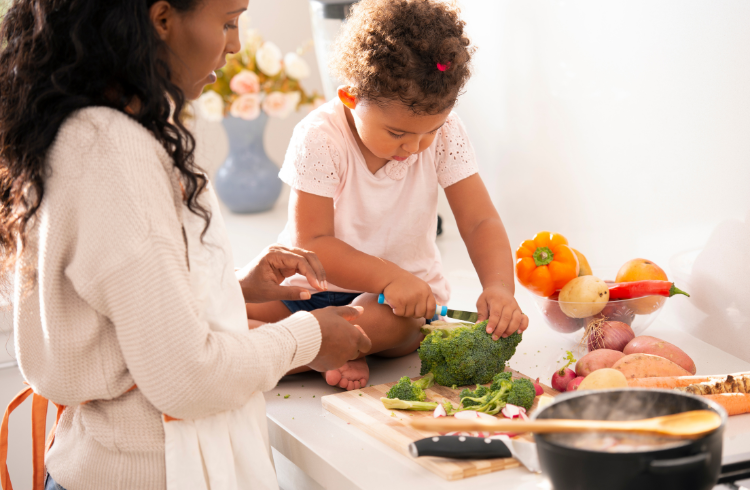

Managing time effectively while preparing meals with kids can be a challenge, but with the right strategies, it can also be an enjoyable and educational experience for both parents and children. Time management is crucial when juggling the demands of meal preparation with the natural unpredictability that comes with having kids in the kitchen. By incorporating simple tips and techniques, parents can create a harmonious balance between cooking nutritious meals and engaging their children in the process.
One of the first steps in managing time efficiently is planning meals in advance. Meal planning can save an enormous amount of time and stress during the week. By sitting down and mapping out the week’s meals, parents can ensure they have all the necessary ingredients on hand, which minimizes last-minute trips to the grocery store. Planning also allows for the integration of variety and nutrition into the weekly menu, ensuring that meals are balanced and aligned with dietary needs. Additionally, when meals are planned, it becomes easier to incorporate tasks that kids can help with, such as washing vegetables or setting the table, into the preparation process.
Prepping ingredients ahead of time is another invaluable tip for managing time effectively. Chopping vegetables, marinating proteins, or even preparing whole dishes in advance can make the actual cooking process much smoother and faster. This is particularly useful when cooking with kids, as it allows parents to focus on engaging with their children rather than rushing through complicated tasks. Setting aside a specific time, such as on the weekend, to prepare ingredients for the week can significantly reduce the daily workload. This not only streamlines the cooking process but also helps in maintaining a calm and organized kitchen environment, which is beneficial when children are involved.
When cooking with kids, it’s important to embrace simple, kid-friendly recipes that don’t require extensive preparation or complicated techniques. Recipes that can be assembled quickly and don’t involve too many steps are ideal for keeping both parents and children focused and on track. Dishes like pasta, stir-fries, or sheet pan meals are great options because they are easy to prepare and cook relatively quickly. These types of meals also offer opportunities for kids to participate in safe and simple tasks, such as stirring ingredients, sprinkling cheese, or arranging vegetables on a tray. By keeping the recipes straightforward, parents can ensure that meal preparation remains an enjoyable activity rather than a stressful chore.
Involving kids in the meal preparation process is not only a great way to spend quality time together but also an effective time management strategy. Children who are engaged in cooking are less likely to become restless or distracted, which can help keep the process running smoothly. Assigning age-appropriate tasks, such as washing produce, mixing ingredients, or even cracking eggs, can make kids feel like they are contributing meaningfully to the meal. This not only helps in managing time but also teaches children valuable life skills, such as teamwork, following instructions, and understanding the basics of cooking. It’s important, however, to remain patient and flexible, as involving kids in cooking can sometimes slow down the process. Viewing this time as an opportunity for learning and bonding rather than a race against the clock can make the experience more enjoyable for everyone involved.
Another effective time management tip is to make use of modern kitchen appliances and tools that can simplify meal preparation. Slow cookers, for example, allow parents to prepare meals in the morning or the night before, which can then cook throughout the day with minimal supervision. This frees up time in the evening for other activities, such as helping kids with homework or spending time together as a family. Food processors and blenders can also speed up tasks like chopping, pureeing, or mixing, making it easier to prepare meals quickly. Utilizing these tools not only saves time but also allows parents to focus more on interacting with their kids rather than being tied up with lengthy cooking processes.
Keeping the kitchen organized is another crucial aspect of managing time efficiently when preparing meals with kids. A well-organized kitchen allows parents to find ingredients and tools quickly, reducing the time spent searching for items. It also makes it easier to involve kids in the process, as they can be shown where to find utensils, ingredients, or cleaning supplies. Labeling containers, arranging ingredients by category, and keeping frequently used items within easy reach are all simple ways to maintain an organized kitchen. Teaching kids to clean up as they go, by putting away ingredients or washing dishes after use, can also help maintain order and save time on post-meal cleanup.
Finally, it’s important to remember that flexibility and adaptability are key when managing time in the kitchen with kids. Despite the best planning and organization, unexpected challenges can arise, such as a recipe taking longer than anticipated or a child needing extra attention. In these situations, it’s essential to remain calm and adjust the plan as needed. This might mean simplifying a recipe on the fly, delegating a task to an older child, or even deciding to save a more complicated dish for another day. Being flexible ensures that meal preparation remains a positive experience, even when things don’t go exactly as planned.
In conclusion, time management when preparing meals with kids is about finding a balance between efficiency and engagement. By planning meals in advance, prepping ingredients, embracing simple recipes, involving kids in the process, utilizing kitchen tools, keeping the kitchen organized, and staying flexible, parents can create an enjoyable and productive cooking environment. This approach not only makes meal preparation more manageable but also turns it into a valuable opportunity for family bonding and teaching kids important skills that will serve them well throughout their lives.
Precautions to consider when cooking with kids

Preparing meals with children can be a fun and educational experience, but it’s important to take necessary precautions to ensure safety and avoid potential risks. Here are some key precautions to keep in mind when cooking with kids:
1. Supervise at All Times
- Always keep a close eye on children while they are in the kitchen. Even simple tasks can become hazardous if not properly supervised.
- Be actively involved in what they are doing, providing guidance and correcting mistakes in real-time to prevent accidents.
2. Teach Kitchen Safety Rules
- Establish that the kitchen is a no-running zone to prevent slips, trips, and falls.
- Teach children how to properly use kitchen tools, such as knives, peelers, and graters, emphasizing the importance of handling them with care.
- Make sure children know which surfaces and utensils are hot and to keep a safe distance from the stove, oven, and boiling pots.
3. Age-Appropriate Tasks
- Assign kitchen tasks based on the child’s age and ability. Younger children can wash vegetables, mix ingredients, or help set the table, while older children can handle more complex tasks like measuring and cutting.
- Children under the age of 8 should avoid using sharp knives or tools. Use kid-friendly utensils or pre-cut ingredients when necessary.
4. Practice Proper Hygiene
- Teach children to wash their hands thoroughly with soap and water before starting any food preparation and after handling raw ingredients like meat or eggs.
- Ensure that all surfaces, utensils, and equipment are clean before starting. Regularly wipe down work areas and utensils during cooking to prevent cross-contamination.
5. Keep Ingredients and Allergens in Mind
- Be aware of any food allergies that your child or others in the household may have, and avoid using those ingredients in recipes.
- Teach children to read food labels and understand the importance of checking for allergens, especially when trying new ingredients.
6. Use Child-Safe Tools and Equipment
- Use tools designed for children, such as plastic knives, smaller mixing bowls, and safety scissors, to reduce the risk of injury.
- Ensure that all appliances and tools are securely placed and stable to avoid spills or falls.
7. Manage Heat and Flames Carefully
- When cooking on the stove, use the back burners whenever possible and turn pot handles inward to prevent accidental knocks.
- Children should not operate the oven without adult supervision. Teach them to stand clear when opening the oven to avoid burns from hot air or steam.
8. Prevent Choking Hazards
- Cut food into small, manageable pieces to reduce the risk of choking, especially for younger children.
- Be cautious with foods that can be choking hazards, such as whole grapes, nuts, and hard candies. Modify recipes to make them safer if needed.
9. Emergency Preparedness
- Be familiar with basic first aid procedures, such as how to treat burns, cuts, and choking incidents. Keep a first aid kit handy in the kitchen.
- Keep a fire extinguisher accessible in the kitchen and know how to use it. Teach children what to do in case of a fire, such as how to stop, drop, and roll.
10. Clean Up Safely
- Dispose of sharp objects, like broken glass or can lids, safely to prevent injuries during clean-up.
- Wipe up any spills immediately to prevent slipping hazards, especially if children are still in the kitchen.
By following these precautions, parents can create a safe and enjoyable cooking environment for their children. Teaching kids about kitchen safety from an early age not only protects them from risks but also empowers them with skills and knowledge that will benefit them as they grow.

